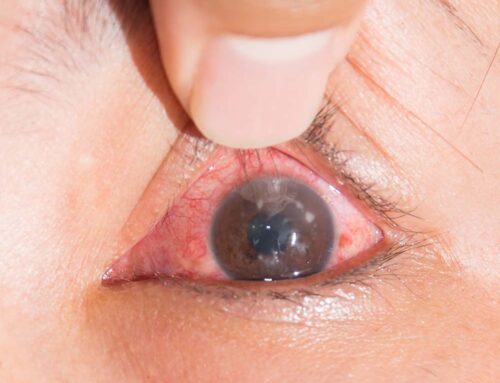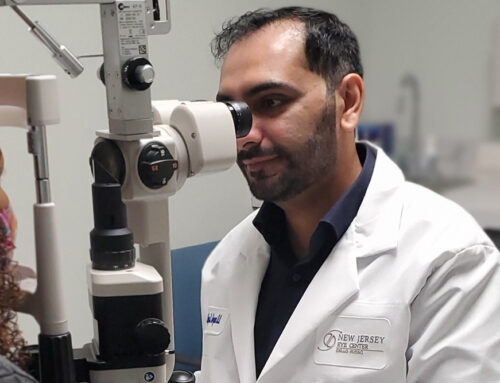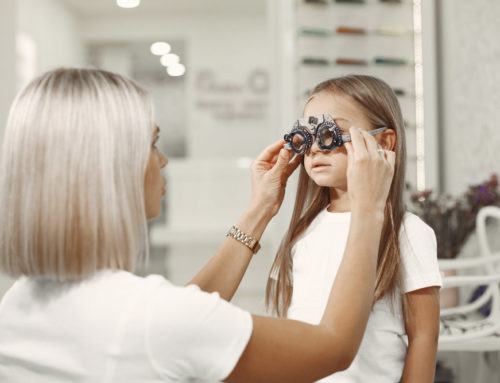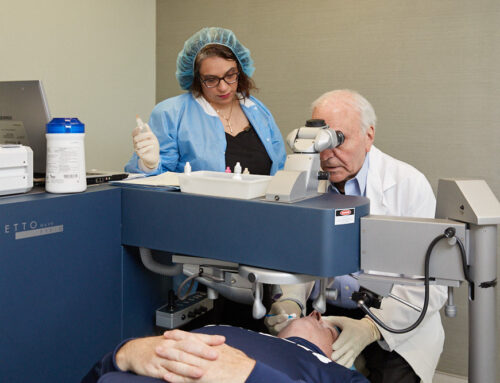
We have all suffered from watery eyes at some point in our lives. It can happen when we laugh, yawn, or spend too much time in front of a computer screen. However, often we do not know why it happens.
Tears are produced to keep our eyes lubricated and to remove any foreign bodies that may have entered them. Watery eyes occur when there are too many tears being produced. The result gives a glassy appearance and the tears start flowing.
What might cause excessive tearing?
Excessive tear production can occur naturally – when out on a windy day or if something gets into the eye. In these instances, the tears are temporary and go away very quickly. However, it is when the tears do not stop, that they become an irritating problem.
Although not usually harmful, it’s important to identify the reason for watery eyes and to treat it correctly.
Dry Eyes
It may sound strange, but having dry eyes is a common reason for excessive tearing. Your immune system tries to compensate for the dryness by producing tears to alleviate irritation.
Autoimmune diseases, like rheumatoid arthritis, or exposure to smoky or windy environments can cause dry eyes. It is also something which becomes more common as we age. If the underlying cause is not addressed, the watery eyes will just continue.
Allergies
Many millions of people suffer from eye allergies. Whether it is a reaction to flora or fauna, exposure to pet hair, pollen or dust, all can produce too many tears. It’s important to find out what you are allergic to and minimize your exposure. Antihistamine tablets can help alleviate symptoms.
Styes
If you notice a little red bump on your eyelid which hurts, you may have a stye. In many cases, they are caused by a bacterial infection.
Although not a serious condition, they can be very annoying. It can be very tempting to pop a stye. If you do, the infection will spread. Better to leave it to the doctor! He or she may also prescribe a course of antibiotics.
Blocked tear ducts
After washing across the eye, tears are drained through small holes in its corner, known as tear ducts. Maybe due to an infection or inflammation, the ducts can sometimes become blocked.
As they are unable to drain, tears accumulate, causing irritated and watery eyes. Other indications are blurred vision, blood in your tears and crusty eyelashes.
Pink eye (Conjunctivitis)
This is an infection of the thin, transparent layer covering the white part of the eye (the conjunctiva). Most often it is caused by the same virus as the common cold or flu. Watery eyes are just one symptom of pink eye. When inflamed, blood vessels dilate and the eye takes on a pink or red color. There may also be some itchiness and pain.
Although not difficult to treat, conjunctivitis needs to be identified quickly. It is highly contagious and precautions need to be taken immediately to prevent it from spreading. Keep children off from school and stay away from work for at least a week. Make sure to wash your hands regularly.
Problems with the cornea
The cornea is the outer layer of the eye and the first thing that comes into contact with foreign objects. For example, a piece of grit or dust may get into your eye, which could scratch the cornea. You might experience watery eyes which are painful and become more sensitive to light. The feeling of having something in your eye when it is closed can be very common.
More serious problems can be inflammation of the cornea and ulcers (open sores). In these instances, visit your doctor right away. Any delay could cause permanent damage to your eyesight.
Meibomian gland dysfunction (MGD)
The meibomian glands are located on the rim of the eyelids. They produce an oily substance which is a component of tears, stopping the water in them from evaporating. When the glands do not produce the correct quantity or quality of oil, your eyes become dry. And as we know, when you have dry eyes, watery eyes occur– a never-ending cycle.
MGD is a common eye condition which many people do not even realize they have. In the early stages, watery eyes may be the only symptom. As MGD progresses, you may experience irritation and itchiness, and a feeling of having grit or dust in your eye.
Bell’s palsy
Experts are not sure what causes Bell’s palsy. Some nerves in the face are affected, and become paralyzed or weak. The act of blinking distributes tears in the eye.
With Bell’s palsy, your eyelids may not be able to close properly, interfering with your ability to blink. It is a condition which usually goes away naturally within a few months.
Watery eyes in the morning
Many of us experience watery eyes in the morning. This is because, having been closed for hours, your pupils react to the sudden introduction of light by producing tears. You will therefore notice that your eyes water more in the mornings.
If this is a constant occurrence, you may have one of the conditions above. If in doubt, seek medical advice.
Home remedies for watery eyes
In many cases, watery eyes will clear up by themselves. However, there are steps that you can take to speed up recovery.
Wet a clean cloth or cotton pad with warm water, and hold it over your eyes for a few minutes. Gently rub your eyelids and the base of your eyelashes.
Use a cotton swab to clean along the line of the eyelash, helping to clear any dust particles.
Gently massage your eyelids. In the case of MGD, this should help increase oil production.
Over-the-counter drops for dry eyes, otherwise known as artificial tears, help to keep the eyes moisturized. Put a couple of drops into your eyes after bathing them.
Seek medical advice
If watery eyes continue to be a problem, you should seek expert advice. Whatever the cause, they all share similar symptoms. If you have any reduced vision, feeling of a foreign body in your eye, or pain, visit a doctor.
Find out what is causing your excess of tears and get the right treatment. We have extensive experience diagnosing and treating all causes of watery eyes. Visit us at the New Jersey Eye Center in Bergenfield, NJ.







